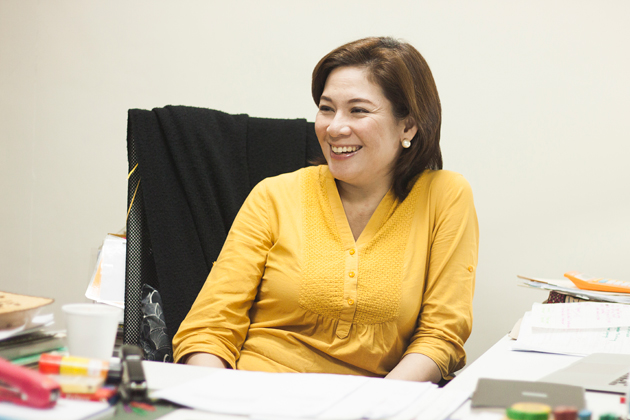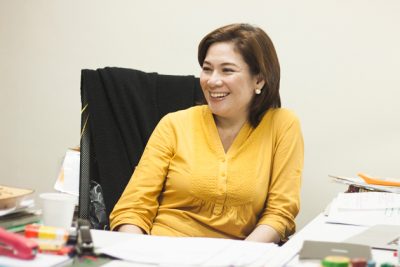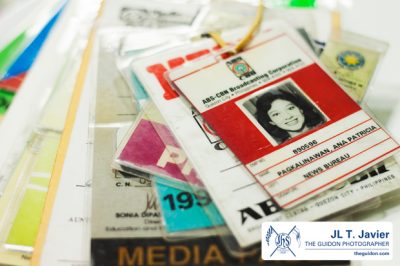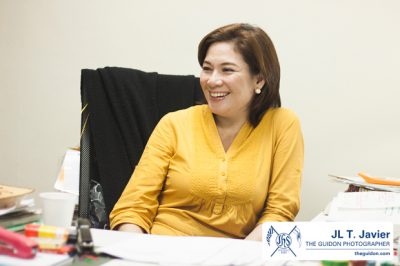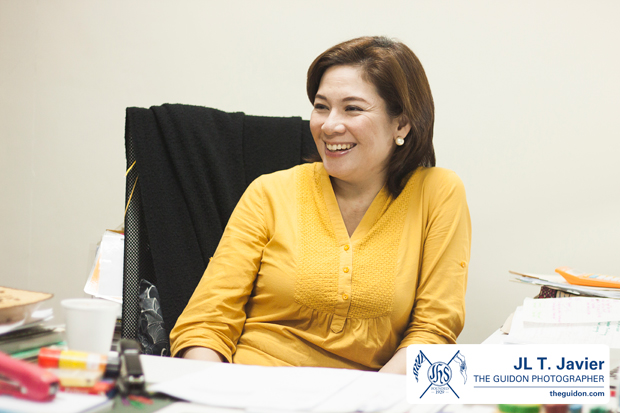
A SEASONED VETERAN. Broadcast journalist Pia Hontiveros holds court in her office at Solar TV. Photo by JL T. Javier.
It was just our luck. We were able to secure an interview with Pia Hontiveros (AB IS ‘89), veteran broadcast journalist known for her no-nonsense attitude, but we were already running late. We expected a tongue-lashing.
Instead, we were greeted with this: the sight of her daughter’s hot pink rain boots on the floor, a tub of colorful markers on the desk and a Hontiveros who didn’t seem at all bothered by our faux pas.
Another side of her seemed to be present. The established journalist noted for her cold professionalism turned to cheeky, self-deprecating humor. Following a remark we made about her journalistic integrity, she joked, “What? Who told you that?”
These would prove to be only a few of many revelations that night, as Hontiveros took us behind the scenes of her career, Philippine media and her life without the glare of the camera.
Breaking new ground
Hontiveros had long worked for ABS-CBN as a reporter and anchor, at one point hosting the political talk show Strictly Politics on the ABS-CBN News Channel (ANC). In 2011, she decided it was time to end her 22-year stint with the network, which came as a surprise to viewers. “There are times you just need to move on,” Hontiveros explains.
She recently became the face of Solar Network News. Although Solar TV doesn’t have the biggest newsroom out there, it is gaining a reputation for its high degree of professionalism, which is something Hontiveros thrives on.
“We’re not trying to challenge anyone,” she says. “We just need to do what we’re good at.”
Though she has spent decades in the business, Hontiveros wasn’t originally set on journalism. It literally took a revolution for her to make up her mind.
After Ferdinand Marcos was overthrown in 1986, the appeal of journalism skyrocketed. For the first time in years, people had the chance to be heard, ushering in an atmosphere of possibility. “All the democratic space was there,” says Hontiveros. “[Journalism gives you] the front seat of history in the making.”
As a curious college sophomore, Hontiveros chose to spend time hanging around the ABS-CBN newsroom, where her uncle Jimmy Navarro was Program Director—instead of spending time in class. It was this experience that sparked her desire to be a broadcast journalist.
She was already writing as part of The GUIDON, but she remembers having much to learn. “I wasn’t even a great writer before, susmaryosep.” Still, being part of the student publication proved to be serendipitous, as she met her husband in the Publications Room in the summer of 1987.
Her unconventional method of learning earned her the ire of some people—as Hontiveros recalls, one teacher told her class that she would never get far in journalism. Decades later, Hontiveros remains the only one from that class who became a successful broadcast journalist.
Her experience would pay off in later years. Hontiveros says, “The best classroom for a journalist is the field. We send you out, then bahala ka sa buhay mo (you’re in charge of your life).” A purely academic environment does not suffice.
Do or die
Hontiveros is known to be very strict with her work. “She wants the facts straight,” says Mai Rodriguez, who has worked alongside Hontiveros for six years both as segment producer and weathergirl.
Her thoroughness doesn’t end there. In the live broadcast of Solar Network News, there was a small audio mishap during the traffic report. The show had to cut the segment short, and she sternly told the crew, “Tell them not to use that microphone next time.”
True enough, while she was engaging throughout our interview with her, she was also critical of our questions, brought upon by years of being a journalist herself. She reminded us to verify our facts before anything else.
But behind the journalist who has braved New People’s Army (NPA) attacks, typhoons, and coups d’état is an amicable co-worker. “You can talk to her about anything,” says Rodriguez. “[Even new colleagues] can easily approach her.”
“What is admirable [about her] is that she really earned her stripes as a journalist,” says Patricia Bunye, a college friend of Hontiveros. “[She’s] not like some talking heads now who just read from a teleprompter.”
One test of this was a 1990 assignment in Ragay, Camarines Sur. During our interview with her, she illustrated the entire incident using a tub of her daughter’s markers, even color-coding the characters and the setting. Her meticulousness as a storyteller was nearly a reflex.
The news team had traveled on foot while investigating NPA mass graves. Hontiveros had just interviewed an old man when the gunshots of an automatic weapon rang out. Even in the face of death, her journalistic instincts kicked in. “It was too good to be true, but the camera had gone all the way to the other side,” Hontiveros recalls in a mixture of English and Filipino.
The old man motioned for her to hide with him, but Hontiveros chose to hide with others in a thin-walled nipa hut. “That was the only time as a journalist that I felt like I was going to die.” She made the right choice by hiding in the hut. After the two-hour ordeal, they found the old man with a bullet in his head.
Changing times
Hontiveros possesses an optimism that could be surprising from someone who has seen the grittiest parts of Philippine reality. When asked what media can improve on, she says, “[It can have] a little more of what is good about us as a people. Many stories out there don’t get reported because most of us think only bad news is good news.”
In part, this may have to do with those who present the news. She points out that some journalists tend to be reckless and irresponsible, and stresses on their need to do their job responsibly. “[We need] a little less sensationalism,” she says.
“We are not the story—the story is the story,” says Hontiveros.
Though Hontiveros herself is very much connected to politics, she reiterates that media shouldn’t just be the government’s mouthpiece. At the same time, they should be able to call them out when necessary. “We don’t have to be adversarial,” she says. “We can be partners.”
Meanwhile, as far as traditional media’s gradual transition into an increasingly online platform is concerned, Hontiveros has no problem adapting. “I’m on Facebook, I’m on Twitter, primarily because it helps [journalists] reach out to people,” she says. She notes that social networking sites are vital to today’s journalism because not only are they used to gauge the public’s sentiments on certain issues—they have also become one of the public’s primary sources of information.
Another angle
When she’s not working, Hontiveros spends her time shopping and cleaning at home. “There’s a whole side of me that people don’t see on the camera,” she says. She shares that people are always shocked to know that she’s handy around the house. She also likes organizing family reunions and parties, even ending up hosting the program.
Hontiveros lights up when she starts talking about her kids. “I [also] design costumes for my kids,” she says, and starts animatedly describing the costumes she has made for them. “After 9/11, my son—we made him into a biohazard expert in a blue suit.” She won’t be running out of memorable moments such as this anytime soon; she gave birth to her youngest son just last year at 44. “It was a very nice accident,” she laughs.
“I would run home to my family,” she immediately replies when posed with the possibility of the end of the world. Indeed, she is, first and foremost, a mother. “At the end of your life, it’s not your co-workers who would be surrounding your deathbed and holding onto you and crying. It’s going to be your family.”
She compares balancing work and family to juggling. “Some of [the balls] are glass, some of them are plastic. And actually, the glass ball is family.”
A study in growth
Over the years, Hontiveros has continued to grow beyond herself, and it shows. Mid-interview, she asks if she could leave for a short while to voice the headlines. “[It’ll take] one minute,” Hontiveros reassures us casually, as if she was just going for a walk around her office.
During the newscast, her laptop was positioned just out of the range of the camera. She was using it to check Twitter and Facebook seconds before going on air. For Hontiveros, anchoring seems to be as natural as breathing.
From challenging herself in college, on the field, and as a friend and mother, she continues to surprise the people around her. Her multiple sides do not conflict, but rather, complement one another. She has definitely gone a long way from being the college sophomore who simply found herself in a newsroom out of curiosity.
In the middle of things, Hontiveros returns to her office again, assuming the stance of a supposedly tightly-wound broadcaster. But as she uncovers other roles, she possesses a strong resilience.
She says, “It’s a challenge every day. You have to be on your toes. If you can say ‘I did my job well,’ that’s an achievement in itself.”
- Photo by JL T. Javier.
- Photo by JL T. Javier.
- BEHIND THE SCENES. Hontiveros’ old ABS-CBN ID and work materials are a constant reminder of her days on the field. Photo by JL T. Javier.
- BEHIND THE SCENES. Hontiveros’ old ABS-CBN ID and work materials are a constant reminder of her days on the field. Photo by JL T. Javier.
- A SEASONED VETERAN. Broadcast journalist Pia Hontiveros holds court in her office at Solar TV. Photo by JL T. Javier.

